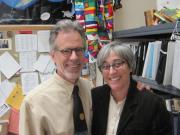Net Energy Zero
Net Energy Zero: New York City PS 62
In April I joined the advisory board of GEMS, world’s largest K-12 educational organization operating some 66 schools in 12 countries around the globe. In the course of a briefing about the new international private school they plan to open in New York City, I received an overview of their architectural plans to renovate a Manhattan office building as a state-of-the art, environmentally sensitive school building. As a result of this meeting, I made another discovery: the project architects, Skidmore, Owings and Merrill (SOM), are designing the city’s first Zero Net Energy school building, a model that promises to transform school architecture.
I have long been interested in the work of Skidmore, Owings and Merrill, in part because the firm’s founder, Nathaniel Owings, was married to Margaret Wentworth, a graduate of the Anna Head/Head Royce School, where I served as principal. Margaret Wentworth, who passed away in 1999, herself was a pillar of strength in the modern environmental movement. Founder and first president of Friends of the Sea Otter, she championed numerous environmental causes, from saving California’s wildlife to preserving the coastline near Monterey. She would be proud today of the success of her alma mater, and of the innovative architectural work of her family’s firm.
It was my good fortune to receive a detailed briefing from the SOM team that is designing the new Zero Net Energy school--Colin Koop, Associate Director; Jon Cicconi, Associate; and Rob Diemer, Partner, In Posse. The term ZNE refers to structures where the building produces on-site renewable energy that is equal to the total energy use, from electricity and from the fuel needed for heating and cooling. Last fall I visited the new, 2009 Putney School Field House in Vermont, the first ZNE secondary school in the country; the first ZNE public school opened in 2010 in Kentucky. Considering that there are 132, 000 schools in the nation’s K-12 system, this new design holds revolutionary potential to bring significant energy and cost savings to the country.
SOM was selected by the School Construction Authority (SCA) in New York City to design a new 444 student, 70,000 square foot, K-5 elementary school that will open in 2015. While NYC enacted a law in 2005 requiring new construction to meet sustainable standards, the SCA has been ahead of the process and is responsible for the largest number of green schools constructed in the city. PS 62 itself will feature the best architectural practices to reduce carbon emissions and achieve energy efficiency. By using passive and natural light, orienting the building to optimize the north-south exposure, wrapping the structure in a photovoltaic covering, and utilizing solar thermal and geo thermal systems, the school will offset its energy use through energy production. The architects also explained their plans for “living courtyards” that will feature edible gardens and for educational efforts to ensure that the building occupants understand how to operate it at peak efficiency.
PS 62 promises to have an impact far beyond the school’s location in Staten Island. With 1.1 million students and 1200 schools, the New York City K-12 educational system has a big footprint, accounting for 37% of the city’s greenhouse gas emissions. With half of the buildings constructed before 1949, clearly there will be significant needs to construct new schools and to modernize existing structures. Rather than using the LEED standards, the SCA has developed its own standards to guide construction and ensure comparable environmental standards, thereby saving the cost of outside certification.
Through its PS 62 school project with SOM, and with the new SCA building standards, New York City is on the threshold of a transformation in school architecture, one that holds the promise of a radical change in the environmental impact of the nation’s schools.







